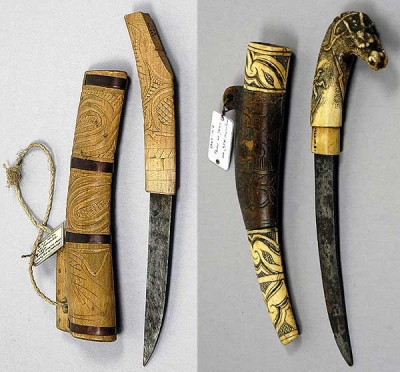Two Ainu knives (1935.74.26)
 JapanTwo Ainu knives from Japan, Asia. Collected by John Church. Lent to the Museum by Alan Coltart in 1935.
JapanTwo Ainu knives from Japan, Asia. Collected by John Church. Lent to the Museum by Alan Coltart in 1935.
The ancient Ainu originated in the far east of Russia but are now settled in the north Japanese island, Hakkaidõ, and the Sakhalin Peninsular. Knives such as these were used in special rituals and kept as heirlooms. Whether made of wood or bone, they are often carved with typical scrollwork decoration. This represents swirling water and reflects the Ainu's seal-hunting economy.
(The knife on the right hand side is object 1960.10.8)
Sacred Weapons
These knives reflect the beliefs and customs of the Ainu, a group whose culture is quite different from that of the Japanese. They have a strong hunting heritage and traditionally believed that all items of material culture contain a spirit. Swords and knives were thought to embody the powerful god, Tomi-Kamui who was obliged to answer the prayers of all Ainu men who carried one. Swords and knives were also placed under the pillows of the critically ill for the same reason.
While the souls of those who died of natural causes or animal attack were considered free to make their way to heaven, the souls of those who had been killed by the blade were believed to wander the earth malevolently. To stop this happening, the male relatives of the victim stood together in their village and simultaneously drew their knives, lifting them up to the sun so that the evil spirit could be exorcised.
Knives were also used in certain rituals. The iku-nishi, on the left, is invested with prayer at inomi dedication ceremonies and then dipped in an offering cup of sake (rice wine), which is then drunk. The makri, on the right (here with a Chinese-inspired dragon's head bone hilt), was covered in bear-penis skins during a ceremony to invoke bear spirits.





